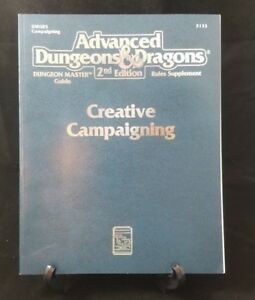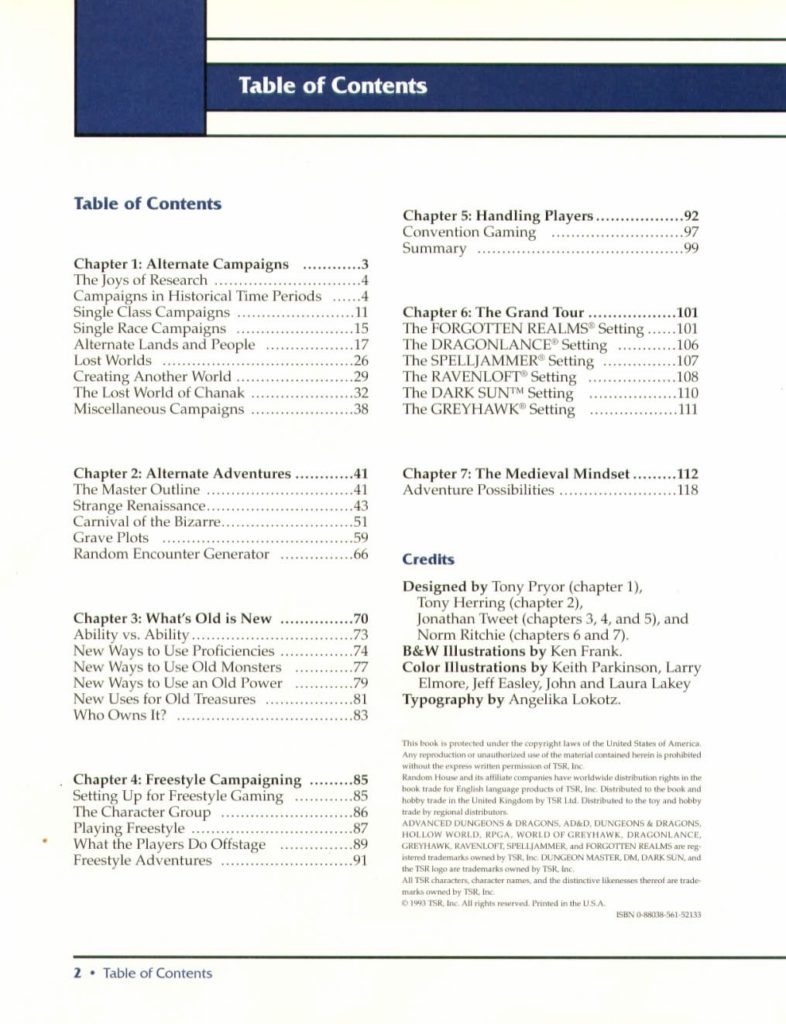
Creative Campaigning
We start the first article of a serie where we will analyze ancient book coming from D&D Old School.
When I say D&D Old School I imply everything about RPG from the D&D world that was published before D&D 3.0 or, generally speaking, the template based known as D20 system.
The book in question, as the title suggests, bears the title of
DMGR5 Creative Campaigning
In other words, Dungeon Master Guide Rulebook n°5.

Those were times where the Dungeon Crawl adventures were the most played. The game was young, the players were youngs and of course the game masters were youngs.
I’m not saying that more sopshisticated styles were absent.
I’m just saying that as many new players out there feel disoriented when approaching rpg games, we too were disoriented…the difference between then and now is that we were not aware of being disoriented.
We were pioneers and we played at the best of our abilities.
That meant designing dungeons and placing monsters.
Dungeons and monsters not always had a logic.
Then came the format called campaign setting . Something structured and planned with the only purpose to bring order where there was chaos.
This book was not present in the italian market, which was very small at that time, so I bought it on Amazon few days ago. I had to read it.
We are not going to review every chapter, just those parts that I consider interesting and worth to be taken into account.
Most of the content is interesting, but not useful to extract tips and stuff.

So, this is the index. It begins with an interesting paragraph “The Joys of Research”. It stimulate you to investigate and research, which is a good first step in RPG games.
I wrote an article about this if you ever want to read it here is the link Game Master Traits – Knowledge
CHAPTER 1: Different Ages, Single Class and Single Race Campaigns
In the first chapter it presents to the reader unusual campaign formats and unusual ways to form parties.
It explains how to implement a setting in ages other than the classical middle age campaign setting. It implement a table where equipment are organized in function of the possible age we want to play with: Bronze Age, Iron Age, Renaissance, Cavalier Era.
It rightfully claims that if we push further the ages, than the AD&D mechanics could not work properly, warning us that we are reaching the limit. Especially when it come to more modern ages like steam age, industrial age and so on.
Then it suggests ways to create parties where all characters have the same class, or belong to the same race.
I played a long campaign which was both single class and single race. We started with the D&D classic ruleset – where race and classes were not splitted yet – and then we made a character conversion to AD&D.
We were all dwarves and warriors, the campaign setting was Mystara.
All our characters came from Rockhome, a dwarf kingdom, and every character came from a different clan.
It is possible to play a campaign as single class and/or single race. It is not easy, but very challenging.
CHAPTER 2: Story Summary and Story Structure
Well, this chapter turn to be a very interesting one. I consider this one the most relevant of all the book.
It starts giving tips about what it calls the Story Summary
It asks you to define four elements:
- Setting or where the campaign is going to take place?
- Characters or who is going to play your campaign, their classes and the starting level.
- Plot or what is going to happen during the campaign and how the characters are going to solve each step.
- Subplots or what else could happen during the campaign that is not essential and yet connected to the main events.
However this is not the most interesting part of the chapter.
I’m talking about the Story Structure.
This one deserves our attention and I consider the elements described very innovative.
However, in order to properly understand this paragraph, we need some foreword.
About what?
About the famous/infamous Three-Act Structure
The Three-Act Structure (link to wikipedia to start digging deeper) is basically a technique where you split a story into three main blocks: Setup, Confrontation, Resolution.

The three blocks may have differents names, but the substance does not change. This technique is used in narrative in order to “give a sense” to the story you are telling or writing.
However, keep in mind that a RPG story is not exactly an ordinary story. We explained this in another article Game Master Traits – Improvisation
Now, the “puritans” of RPG could simply state that, no matter what changes you make, every story has and must follow the Three-Act Structure. No matter what.
However RPG stories are not like every other stories, so we need to focus our attention to some elements we can’t omit.
So, what does the book do? It introduces a couple of acts that the authors consider relevant if we want to create a good RGP story.
These two acts are called Denouement and Reward.
In a RPG story, the denouement is not a secondary, it’s very relevant.
Why Denouement is a key act?
Because this act it’s not the end of a RPG session/adventure, it’s indeed the beginning and the introduction to new paths in your campaign.
When the Three-Act Structure was “invented” and universally adopted in story telling, the concept of stories and episodes was not yet present in the mind of the authors.
They thought about a story, they wrote the story, and that was all. The same was at the theater.
It is possible that some authors in the past thought or tried to implement stories made of episodes. Dante Alighieri and La Divina Commedia could represent an example, but in the end the whole book has always been considered as one bulk.
At best you had what is known as Saga, where a mighty hero is the protagonist of different stories, but not strongly connected to each other like a RPG story.
That is why we must consider Denouement as a tangible act in our campaign structure. As a game master, you can’t simply dismiss this part as a paragraph you read to players, where you resume and explain what the hell happened.
This act needs to be roleplayed, not just read!
This is the moment where players can contribute much more than you can expect!
Because it’s the moment where they autonomously speculate on what to do next, what tracks should be followed. This is a precious moment. Believe me.
Why reward is a key act?
This is another special moment. It’s not about the reward the characters obtain during the adventure. It’s about the reward they get from their “employer” or from their hard time spent adventuring.
As a Game Master you have two options.
The first is to dismiss this act as cold reward give away. Players just take note on their sheet of gold, jewels, magical items and so on.
The second option is to dig deep. What every reward is about? Does any implication exist in keeping the promised reward? This act become more relevant especially when characters are no more low level new comers.
Let’s explain better Denouement and Reward, by making an example.
We will analyze a low level adventure and we’ll se what we can do if we take into account both Denouement and Reward as acts of our RPG stories.
The adventure in question is known as “The Burning Plague”.
Together with “Wreck Ashore” I consider the above mentioned module a classic and a must for every Game Master.
Let’s start to dismantle and analyze this adventure.
Setup
A plague is heavily striking a mining community. The character are properly involved.
Confrontation
The characters start investigating, face enemies, and get close to what is causing the plague.
Climax
The party face the enemy and the source of the plague.
Denouement
The characters has basically saved a small town and their silver mine. They defeat an Orc cleric of Gruumsh who was causing the plague. The townfolks are very grateful.
So, we have three elements that must be taken into account.
- Silver mine: the characters have cleared, doing something that the townfolks were not able to. What if the characters decide to seize the mine? Interesting option if your party includes Lawful Evil, Neutral or Chaotic characters. A player roling a Lawful Evil character will probably consider to seize the mine.
- Orc cleric of Gruumsh: you don’t kill a cleric of Gruumsh, who was bestowed with the power to create an exterminating plague, and get away with it. Every action has consequences. Orcs (and Gruumsh) will surely retaliate.
- Grateful townfolks: provided the characters did not seize the mines or claimed it in other “legal” ways, the town will become a strategic headquarter for the party and each character will (and deserve) to receive long lasting benefits.
Reward
Well, this adventure is for low level character. Actually, the townfolks and the mayor pay 100 gold piece if the party solve their problem.
The mayor will support, as a sign of longlasting gratitude, free lodging and food to every character.
These are the reward proposed in the module.
There are other hidden rewards that can be useful to build another episode.
The body of the Orc cleric. The characters can recover a Speak With Dead scrolls and find a way to use it on the dead orc and learn more about the bigger scheme behind the plague.
The Orc’s holy symbol. A low level cleric can’t unleash such a devastating plague without an extraordinary aid from the a supernatural entity. Probably this holy symbol is not an ordinary one.
In Conclusion
We enriched a simple one shot adventure by adding two more acts.
If some of your players like to investigate, make research, solve puzzle and connect points, you have just made them very happy. Maybe a wizard or a cleric who have the knowledge and skill to figure out what a warrior can’t.
If some of your players are not Lawful Good or Lawful Neutral, you just gave them the opportunity to claim something like a silver mine instead of taking 100 dirty gold coins.
See you soon with the next article. The serie of articles about Old School Review is not over, much more will come.
If you enjoyed it give a like to my page Angry Golem Games
LIBRARY
Products to support the blog



